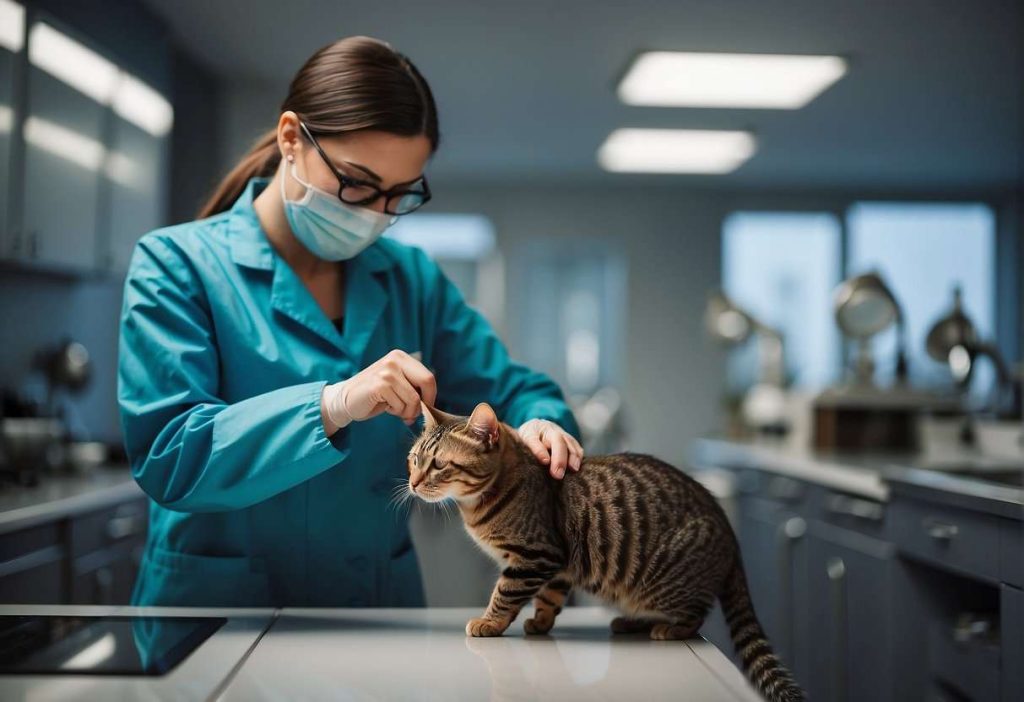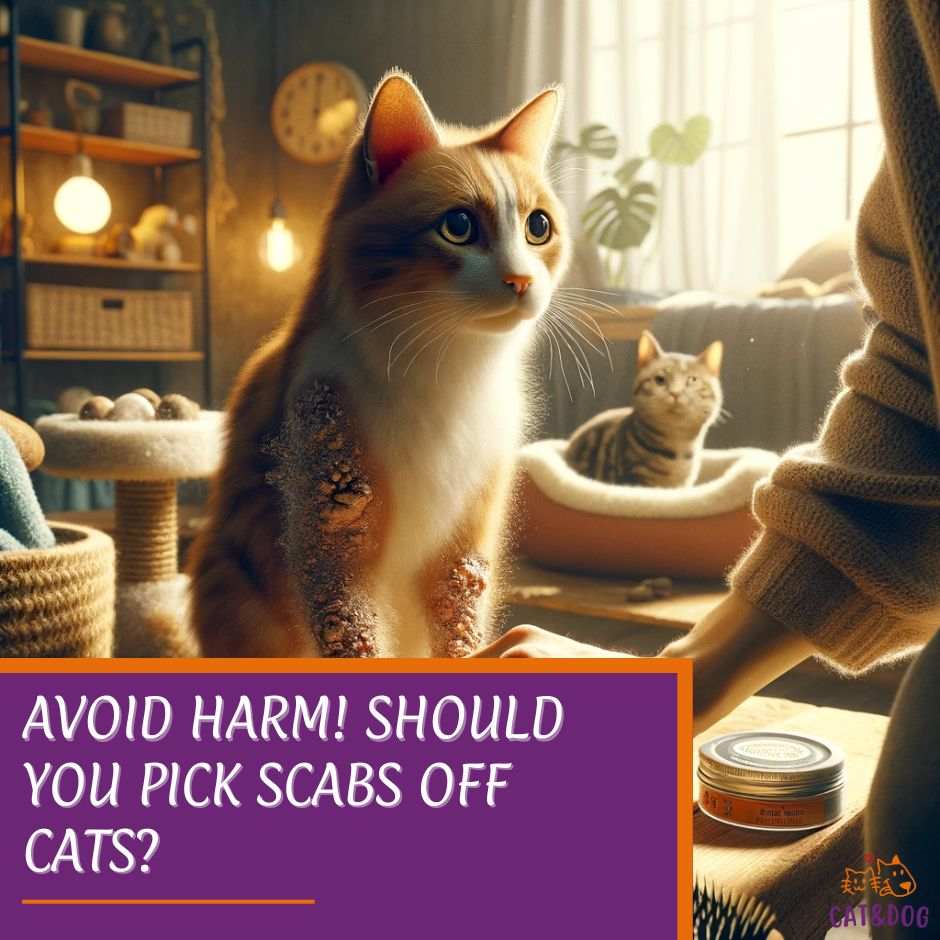Should you pick scabs off cats?
Have you ever noticed a scab on your furry friend and wondered if you need to pick it off?
It’s a common question among cat owners, especially when the scab is visibly irritating your cat or ruining their sleek appearance.
Although it’s hard to resist the urge to remove what seems like a nuisance, it’s essential to understand a few things about scabs before reaching a decision.
Scabs on cats are not merely blemishes; they are part of the natural healing process and serve a protective role for underlying skin issues.
By picking at the scab, you may be masking the underlying cause and making it harder to diagnose and treat, like how Sherlock Holmes always looks for the underlying cause of a mystery instead of just treating the symptoms.

So, what should you do? Before you act, it’s important to recognize the risks of removing a scab prematurely. Much like the scabs on human skin, those on cats are a sign that the body is repairing itself. (1)
Removing a scab can not only reopen the wound and delay healing, but it also exposes your cat to further damage and potential infections.
In contrast, proper care and attention can support your cat’s recovery and ensure the scab falls off naturally and cleanly.
When in doubt, best practice suggests opting for professional veterinary guidance rather than home intervention in the affected area.
Key Takeaways
- Avoid picking at cat scabs, as they are part of the natural healing process.
- Premature removal can lead to infection and delayed wound healing.
- Seeking veterinary advice is recommended for safe and effective treatment.
Understanding Cat Scabs and Skin Health
Ever spotted a scab on your furry friend and wondered what the deal is? Scabs on cats are like nature’s bandages, protecting wounds as they heal. (2)
Think of them as a natural armor shielding vulnerable areas from bacteria and allowing tissue repair underneath.
Here’s a cat fact for you: those scabs are part of the body’s superhero team, fighting off skin infections and ensuring your kitty stays purr-fect.
However, it’s important to understand the healing process and avoid picking at scabs, as this can damage the underlying tissue and lead to further complications.
Common Causes and Triggers You might notice scabs popping up for various reasons:
- Allergies: Just like us, cats can have allergic reactions that cause skin problems.
- Infections: Bacterial or fungal culprits can prompt skin issues. (3)
- Parasites: Fleas be gone! These tiny pests can cause itchiness, leading to scabs. (4)
- Injuries: That adventurous spirit might lead to cuts and scrapes.
- Stress: Surprising, right? Even cats can get stress-related skin conditions.
All set on the details? Armed with this knowledge, you’ll be better at decoding your cat’s skin health. Remember, keeping those kitty scabs intact is always a good idea as they are on a healing mission!
And if anything looks out of the ordinary, a vet’s expertise is just a whisker away. Your four-legged buddy will thank you with extra snuggles, for sure!
Should You Pick Scabs Off Cats? Risks and Reasons Against Picking Scabs

Infection: Opening a Can of Worms Picking at a scab on your cat isn’t just a “no-no” for aesthetic reasons; it creates a doorway for bacteria.
Without the protective scab, the wound can become a playground for infection, causing more harm than good.
Delayed Healing: Two Steps Back Scabs serve a purpose—they’re nature’s bandage. When you remove them, you disrupt the healing process, potentially leading to longer recovery times.
Your cat’s superpower is healing, so don’t take that cape away!
Real-Life Cautionary Tales:
- A cat owner shared that after they removed a scab, their cat’s wound took an extra week to heal.
- A vet reported increased cases of secondary infections when scabs were prematurely removed.
Figuring It Out: The Table of Troubles
| Consequences | Explanation |
| Infection Risk | Unneeded exposure to germs |
| Slow Recovery | Interrupting natural healing |
| Pain and Discomfort | Scabs protect sensitive areas |
Remember, your cat’s skin is working overtime to repair itself, and that scab is a sign of progress. So next time you see a scab, give your cat some extra pets instead of going for the pick.
They’ll thank you with purrs, and you’ll avoid putting them through an unnecessary ordeal of scratching with their claws.
Keep it simple: let scabs be, and keep your kitty on the smooth road to recovery through regular grooming!
Safe Handling of Cat Scabs

Have you ever found yourself eyeing those crusty little spots on your feline friend? Feline scabs, also known as miliary dermatitis, can be tempting to tinker with, huh?
Let’s get one thing straight: It’s vital to resist that urge. Picking can reopen wounds and introduce infection. So, how should you care for your cat’s scabs safely and effectively?
Let’s dive right in with some friendly advice on the best thing to do when you find feline scabs on your cat.
Home Care Remedies:
- Gentle Cleaning: Use a soft, damp cloth to clean around the scab, not directly on it. Just a light pat around the area—no harsh rubbing, okay?
- Natural Healing: Aloe vera can calm the skin, but make sure it’s pet-safe! Speak to your vet about this first—you don’t want to play a guessing game with your cat’s health. (5)
Step-by-Step Guide to Daily Care:
- Inspect the scab: Make it a routine to check—the size, the color, and any discharge.
- Manage Parasites: Fleas & mites can cause scabs. Keep up with your flea control regime.
- Monitor Behavior: Is your cat scratching incessantly? Time to call the vet!
Remember, if you see anything out of the ordinary or if the scab doesn’t improve, book an appointment with your vet. Your cat’s wellness is the ultimate goal here.
Friendly Reminder: Scabs are part of your cat’s natural healing process. They’re like nature’s little bandages.
So, think of yourself as your cat’s wellness coach – there to support, clean and monitor, but not to meddle with the healing.
Keep these tips in mind, and you’ll be on the right track to managing your cat’s scabs effectively, including using natural home remedies to treat cat’s scabs, ensuring they’re on the road to recovery in first place!
Professional Veterinary Care

Professional veterinary care is key when it comes to the well-being of your cat’s skin.
When to Seek Veterinary Help:
- Unexplained Scabs: If scabs appear without any obvious cause, it might be time to pick up the phone and dial your vet. (6)
- Worsening or Spreading: Notice the scabs getting worse or spreading? That’s a red flag waving you to the vet’s door.
- Behavioral Changes: Is your purr-tner more grumpy or less playful? Changes in behavior can signal underlying issues.
- Home Remedies Failing: Tried those internet hacks and they just didn’t cut it? A vet has the right tools to heal and help.
Why Trust the Pros? Professional eyes use science to spot the signs you might miss.
They’re detectives with stethoscopes, backed by studies and research that help pinpoint the cause of those scabs — be it allergies, parasites, or something more complex.
A vet can perform skin tests, recommend lab work, and if needed, prescribe medication or suggest treatments for a range of conditions such as itchy skin, only they can provide.
Keeping Your Kitty in Top Shape:
- Regular Checkups: Like clockwork, yearly checkups can catch early signs of scab-inducing issues.
- Vaccinations and Preventive Care: Protecting your cat from pesky parasites is like giving them a shield against scab-causing villains.
- Tailored Nutrition Plans: Food fuels health, and vets can concoct the perfect meal plan to keep your cat’s skin smooth and scab-free.
So, if in doubt, reach out to your veterinarian. They’re the cat’s meow when it comes to health care, and when you’re aiming for perfection in your cat’s health, they’re your go-to!
Preventive Measures and Long-Term Strategies

Hey there, cat-parent! Ever wondered what you can do to keep your furry friend’s skin healthy and scab-free? Let’s dive into nutrition and grooming, the dynamic duo of preventive care.
Nutrition is the unsung hero of skin health. Feeding your cat a balanced diet rich in omega-3 fatty acids, such as coconut oil, can work wonders. You can also use vitamin C to improve the health of your cat’s skin.
These nutrients are like a spa treatment from the inside out, keeping your cat’s fur shiny and skin supple. Preventive measures and long-term strategies, such as regular grooming and potential dietary adjustments, can also be crucial in promoting skin health and should be considered when planning your cat’s diet.
Remember, your cat’s well-being is paramount, and consulting a veterinarian is essential for an accurate diagnosis and appropriate treatment plan.
But, it’s not just about what they munch on; grooming plays a starring role too. Regular brushing can prevent skin issues by removing loose fur and spreading natural oils.
Plus, it’s a nice bonding experience – who doesn’t love a good petting session?
- Diet Tips:
- Omega-3 Rich Foods: Salmon, flaxseeds, or specially formulated cat foods with omega-3s.
- Hydration: Always have water available to keep your cat well-hydrated.
- Grooming Routine:
- Regular Brushing: Use a cat-friendly brush gently on their coat once or twice a week.
- Bathing: Cats usually don’t need baths often, but if necessary, use a gentle cat-specific shampoo.
Now, transitioning to ongoing monitoring and management—you’re on bug watch, friend! Keep an eye out for those early signs like excessive scratching, which might indicate something’s amiss.
Nobody knows your cat like you do, so you’re the first line of defense if you spot anything off.
- Regular Check-Ups:Vet Visits: Schedule annual check-ups or more frequently as your vet advises.
- Vaccinations: Up-to-date vaccinations can prevent many skin problems. (7)
Remember, early recognition is key. This isn’t just a watch-and-wait game; it’s proactive patrol.
Keep these strategies up, and you’ll be well on your way to ensuring your cat’s skin stays as flawless as a sunbeam on a lazy afternoon!
Quick Recap
Have you caught yourself eyeing those scabs on your cat, itching to pick at them? Hold that thought! Here’s what you need to remember:
- Let Heal Naturally: Scabs are your cat’s natural band-aid. Picking at them can lead to infection, delayed healing, or even scarring.
- Avoid Pain: It might seem helpful, but removing scabs can cause your furry friend discomfort or pain.
- Vet is Best: When in doubt, consult your vet. They have the know-how to address the root cause of the scabs.
So, resist the urge to pick! Instead, monitor the area and keep your cat comfortable. If you’re concerned or if the scabs don’t improve, don’t hesitate to call your vet.
Remember, their health and comfort are top priorities, and keeping those paws off the scabs is a simple way to show your love for your whiskered companion.
Frequently Asked Questions
Navigating the care of your feline friend’s skin can raise many questions. This section addresses common concerns about scabs on cats and how to handle them properly for your kitty’s health and comfort.
What can cause scabs on my cat’s skin?
Various factors can lead to scabs on your cat’s skin, such as flea infestations, allergic reactions, fungal infections, or even physical trauma.
Identifying the cause is crucial for accurate treatment.
Are cat scabs always a sign of a serious health problem?
Not always. Scabs might just indicate minor issues like a scratch or an allergy.
However, persistent or multiple scabs warrant a closer look by a vet to rule out anything more serious.
Are there any effective home remedies to soothe my cat’s scabby skin?
Yes, you can gently clean the area with a mild antiseptic solution and apply a vet-recommended topical treatment to alleviate irritation.
Always consult with your vet first, though, to avoid any complications.
Could my indoor cat’s scabs be a sign of ringworm or another serious condition?
Indeed, indoor cats aren’t immune to skin conditions like ringworm, which can cause scabs. If you suspect ringworm or are unsure about the cause, it’s best to visit the vet.
Is it harmful to my cat if I pick their scabs, and why might they seem to like it?
Picking scabs can be harmful as it may reopen and infect the wound underneath. Your cat may seem to like it because of the immediate relief it feels, but it’s a no-go for the healing process.
When should a scab be left alone, and when should it be treated?
Leave a scab alone if it’s small and your cat isn’t bothered by it.
If the scab is large, there are several, or they seem to cause discomfort, your vet should treat them professionally.
What are the long-term effects of improperly treated cat scabs?
Improper treatment can lead to infections and possibly chronic skin issues.
Scars or recurrences of skin problems can be more likely, so it’s key to treat scabs properly right from the start.
- How to Perform at an Online Casino - July 7, 2025
- Free Slots With Bonus and Free Spins - July 6, 2025


